Organisational Behaviour: Structure, Culture, and Innovation
VerifiedAdded on 2023/04/21
|11
|818
|428
Report
AI Summary
This report provides an analysis of organizational behaviour, focusing on different organizational structures such as formal, informal, line, functional, and matrix structures. It evaluates the importance of organizational culture in developing organizational effectiveness, using Sainsbury as a case study and highlighting the benefits of a positive work environment and ethical framework. The report further discusses the facilitation of innovation and creativity, the importance of learning, and the effectiveness of team working within an organization. Finally, it addresses effective management of change, emphasizing its significance in maintaining competitiveness and adapting to market dynamics, including the role of mergers and acquisitions. The report concludes with a list of relevant references.
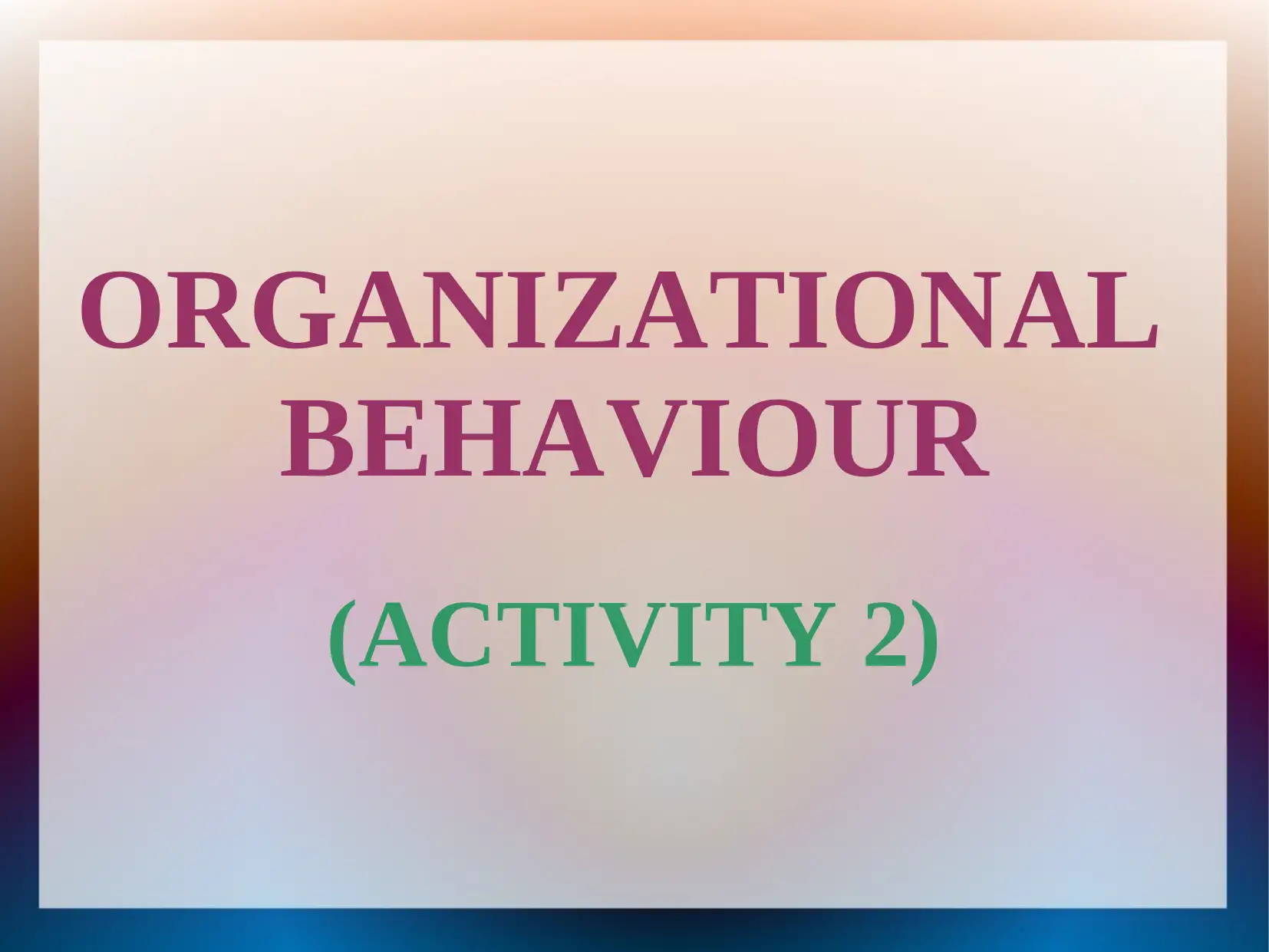
ORGANIZATIONAL
BEHAVIOUR
(ACTIVITY 2)
BEHAVIOUR
(ACTIVITY 2)
Paraphrase This Document
Need a fresh take? Get an instant paraphrase of this document with our AI Paraphraser
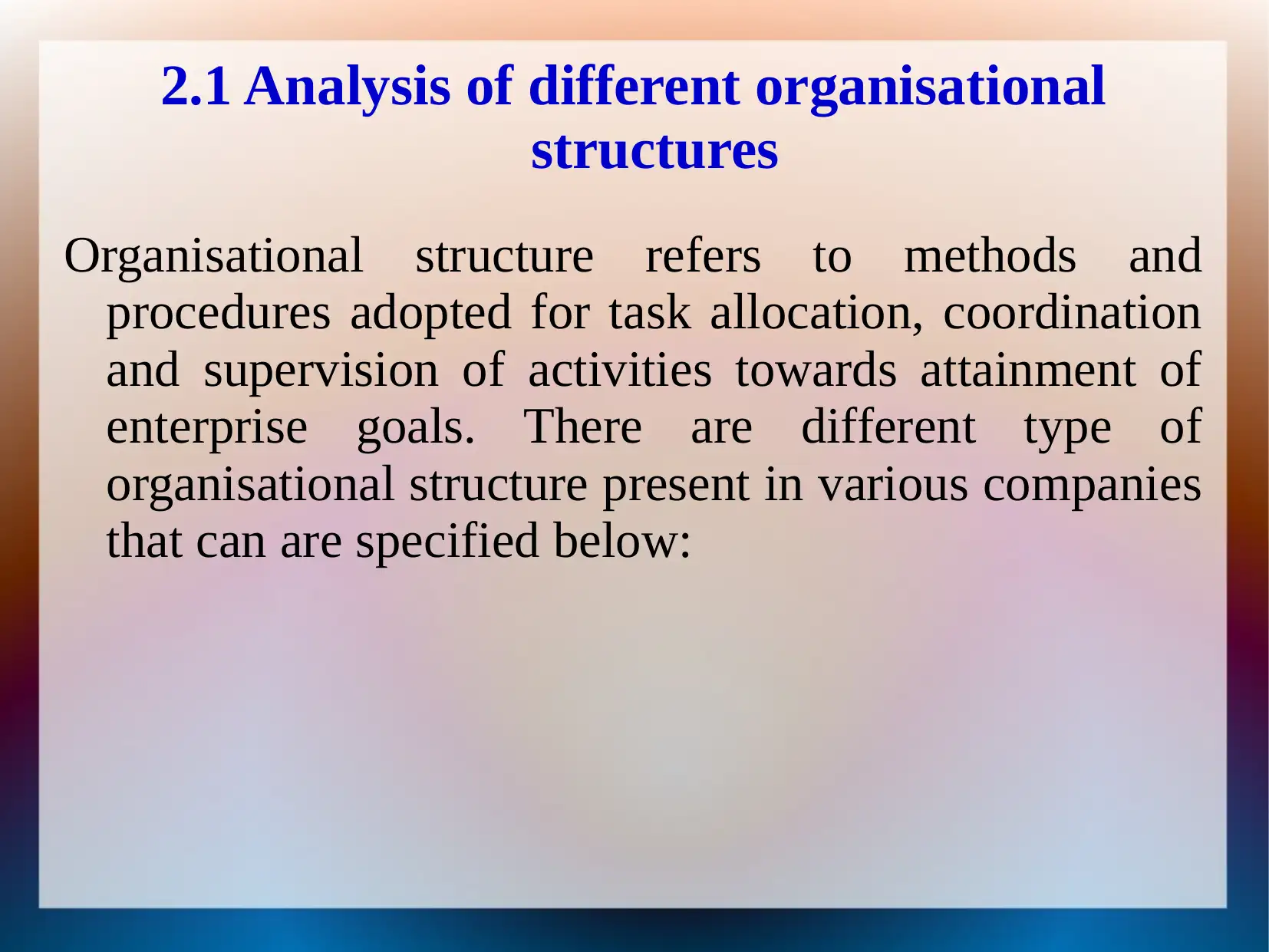
2.1 Analysis of different organisational
structures
Organisational structure refers to methods and
procedures adopted for task allocation, coordination
and supervision of activities towards attainment of
enterprise goals. There are different type of
organisational structure present in various companies
that can are specified below:
structures
Organisational structure refers to methods and
procedures adopted for task allocation, coordination
and supervision of activities towards attainment of
enterprise goals. There are different type of
organisational structure present in various companies
that can are specified below:
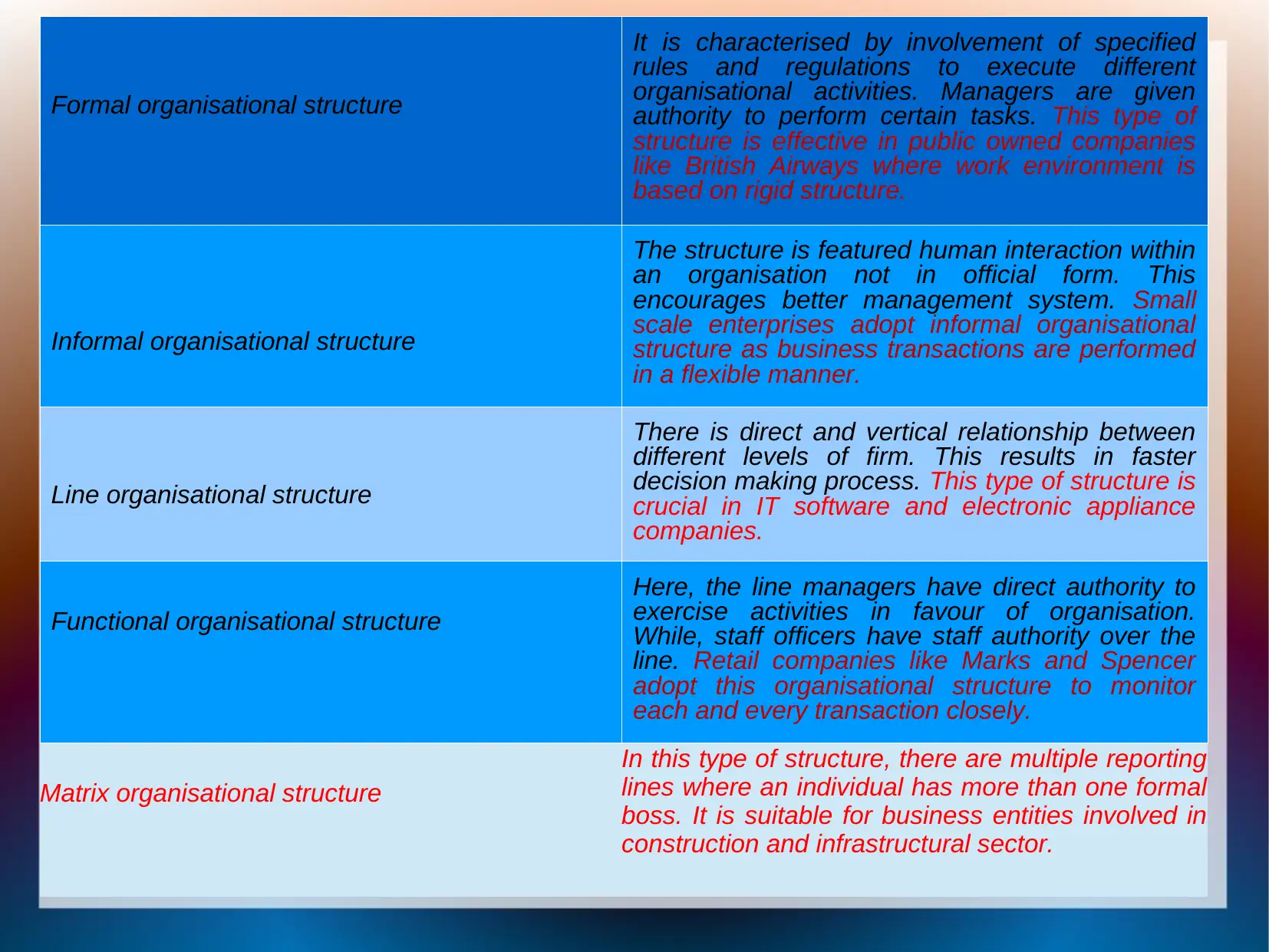
Formal organisational structure
It is characterised by involvement of specified
rules and regulations to execute different
organisational activities. Managers are given
authority to perform certain tasks. This type of
structure is effective in public owned companies
like British Airways where work environment is
based on rigid structure.
Informal organisational structure
The structure is featured human interaction within
an organisation not in official form. This
encourages better management system. Small
scale enterprises adopt informal organisational
structure as business transactions are performed
in a flexible manner.
Line organisational structure
There is direct and vertical relationship between
different levels of firm. This results in faster
decision making process. This type of structure is
crucial in IT software and electronic appliance
companies.
Functional organisational structure
Here, the line managers have direct authority to
exercise activities in favour of organisation.
While, staff officers have staff authority over the
line. Retail companies like Marks and Spencer
adopt this organisational structure to monitor
each and every transaction closely.
Matrix organisational structure
In this type of structure, there are multiple reporting
lines where an individual has more than one formal
boss. It is suitable for business entities involved in
construction and infrastructural sector.
It is characterised by involvement of specified
rules and regulations to execute different
organisational activities. Managers are given
authority to perform certain tasks. This type of
structure is effective in public owned companies
like British Airways where work environment is
based on rigid structure.
Informal organisational structure
The structure is featured human interaction within
an organisation not in official form. This
encourages better management system. Small
scale enterprises adopt informal organisational
structure as business transactions are performed
in a flexible manner.
Line organisational structure
There is direct and vertical relationship between
different levels of firm. This results in faster
decision making process. This type of structure is
crucial in IT software and electronic appliance
companies.
Functional organisational structure
Here, the line managers have direct authority to
exercise activities in favour of organisation.
While, staff officers have staff authority over the
line. Retail companies like Marks and Spencer
adopt this organisational structure to monitor
each and every transaction closely.
Matrix organisational structure
In this type of structure, there are multiple reporting
lines where an individual has more than one formal
boss. It is suitable for business entities involved in
construction and infrastructural sector.
⊘ This is a preview!⊘
Do you want full access?
Subscribe today to unlock all pages.

Trusted by 1+ million students worldwide
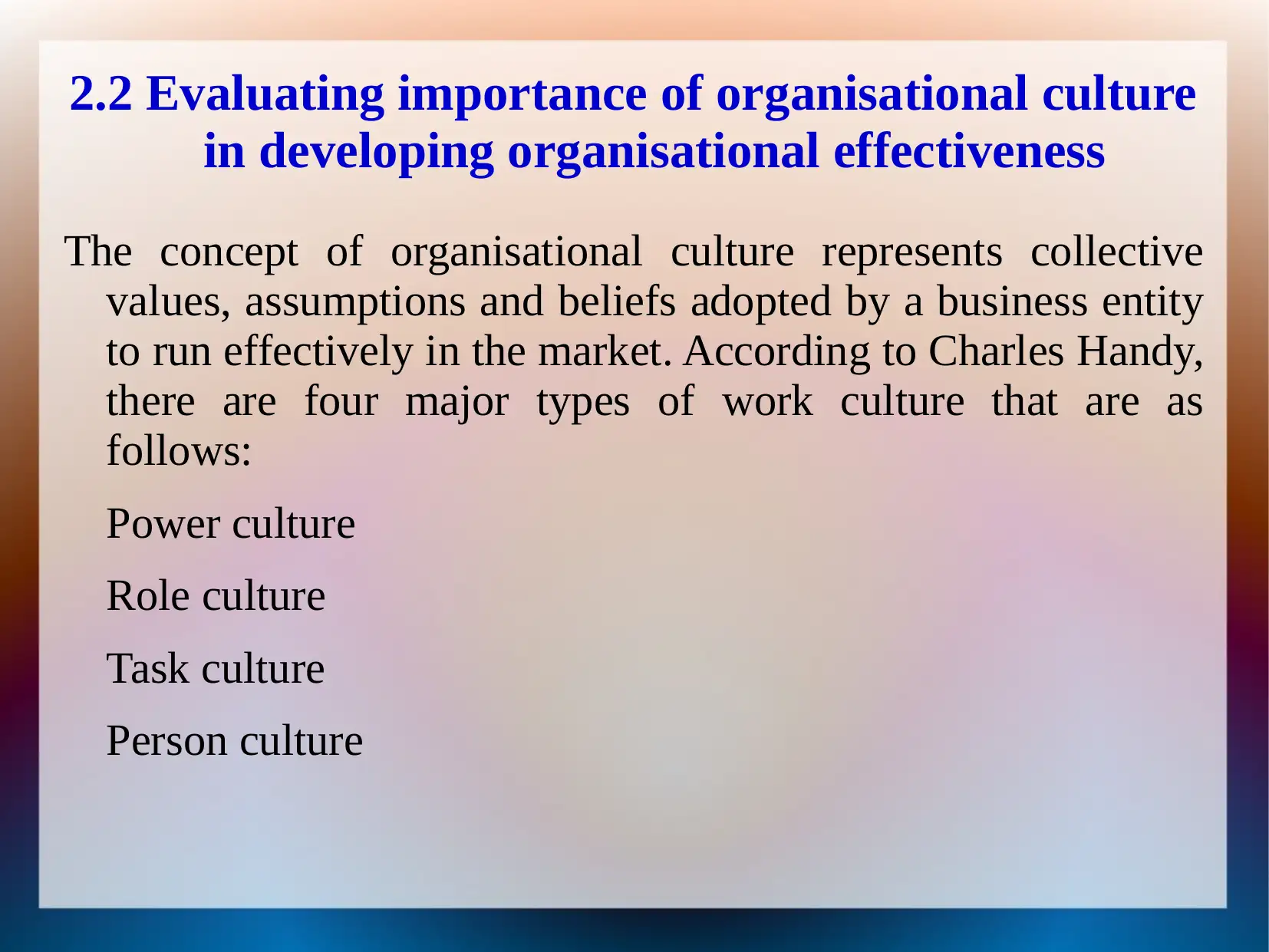
2.2 Evaluating importance of organisational culture
in developing organisational effectiveness
The concept of organisational culture represents collective
values, assumptions and beliefs adopted by a business entity
to run effectively in the market. According to Charles Handy,
there are four major types of work culture that are as
follows:
Power culture
Role culture
Task culture
Person culture
in developing organisational effectiveness
The concept of organisational culture represents collective
values, assumptions and beliefs adopted by a business entity
to run effectively in the market. According to Charles Handy,
there are four major types of work culture that are as
follows:
Power culture
Role culture
Task culture
Person culture
Paraphrase This Document
Need a fresh take? Get an instant paraphrase of this document with our AI Paraphraser
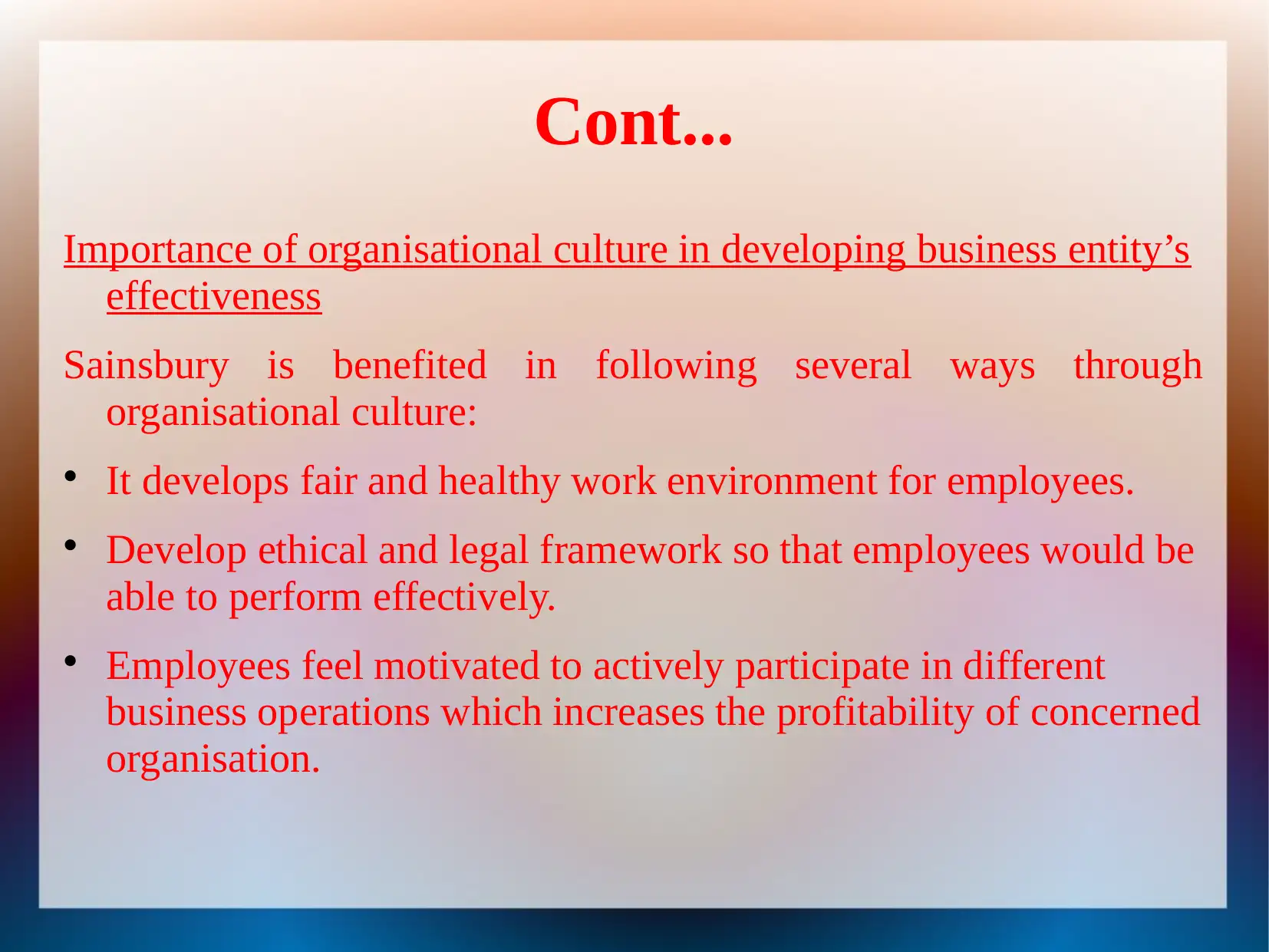
Cont...
Importance of organisational culture in developing business entity’s
effectiveness
Sainsbury is benefited in following several ways through
organisational culture:
It develops fair and healthy work environment for employees.
Develop ethical and legal framework so that employees would be
able to perform effectively.
Employees feel motivated to actively participate in different
business operations which increases the profitability of concerned
organisation.
Importance of organisational culture in developing business entity’s
effectiveness
Sainsbury is benefited in following several ways through
organisational culture:
It develops fair and healthy work environment for employees.
Develop ethical and legal framework so that employees would be
able to perform effectively.
Employees feel motivated to actively participate in different
business operations which increases the profitability of concerned
organisation.
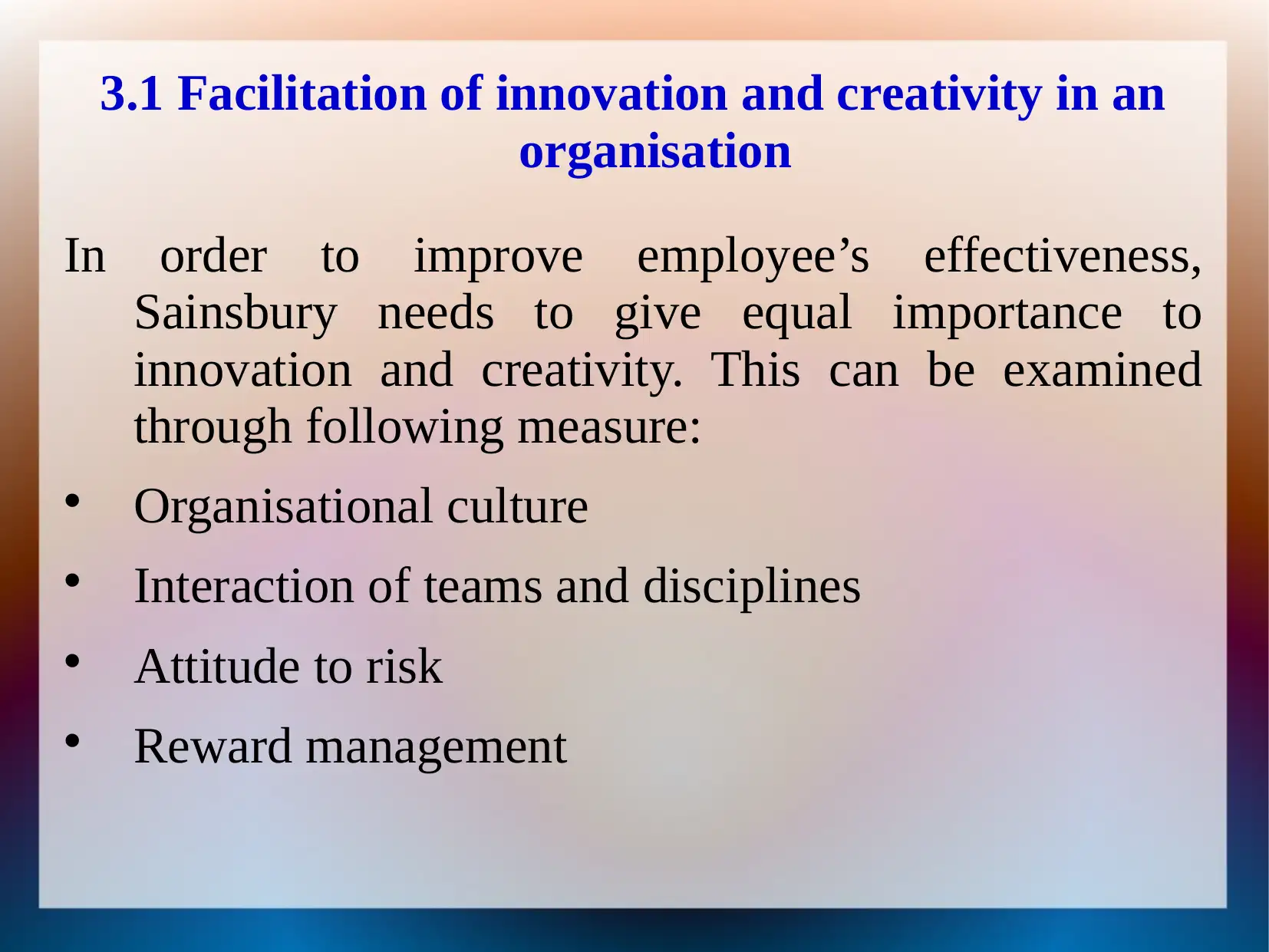
3.1 Facilitation of innovation and creativity in an
organisation
In order to improve employee’s effectiveness,
Sainsbury needs to give equal importance to
innovation and creativity. This can be examined
through following measure:
Organisational culture
Interaction of teams and disciplines
Attitude to risk
Reward management
organisation
In order to improve employee’s effectiveness,
Sainsbury needs to give equal importance to
innovation and creativity. This can be examined
through following measure:
Organisational culture
Interaction of teams and disciplines
Attitude to risk
Reward management
⊘ This is a preview!⊘
Do you want full access?
Subscribe today to unlock all pages.

Trusted by 1+ million students worldwide
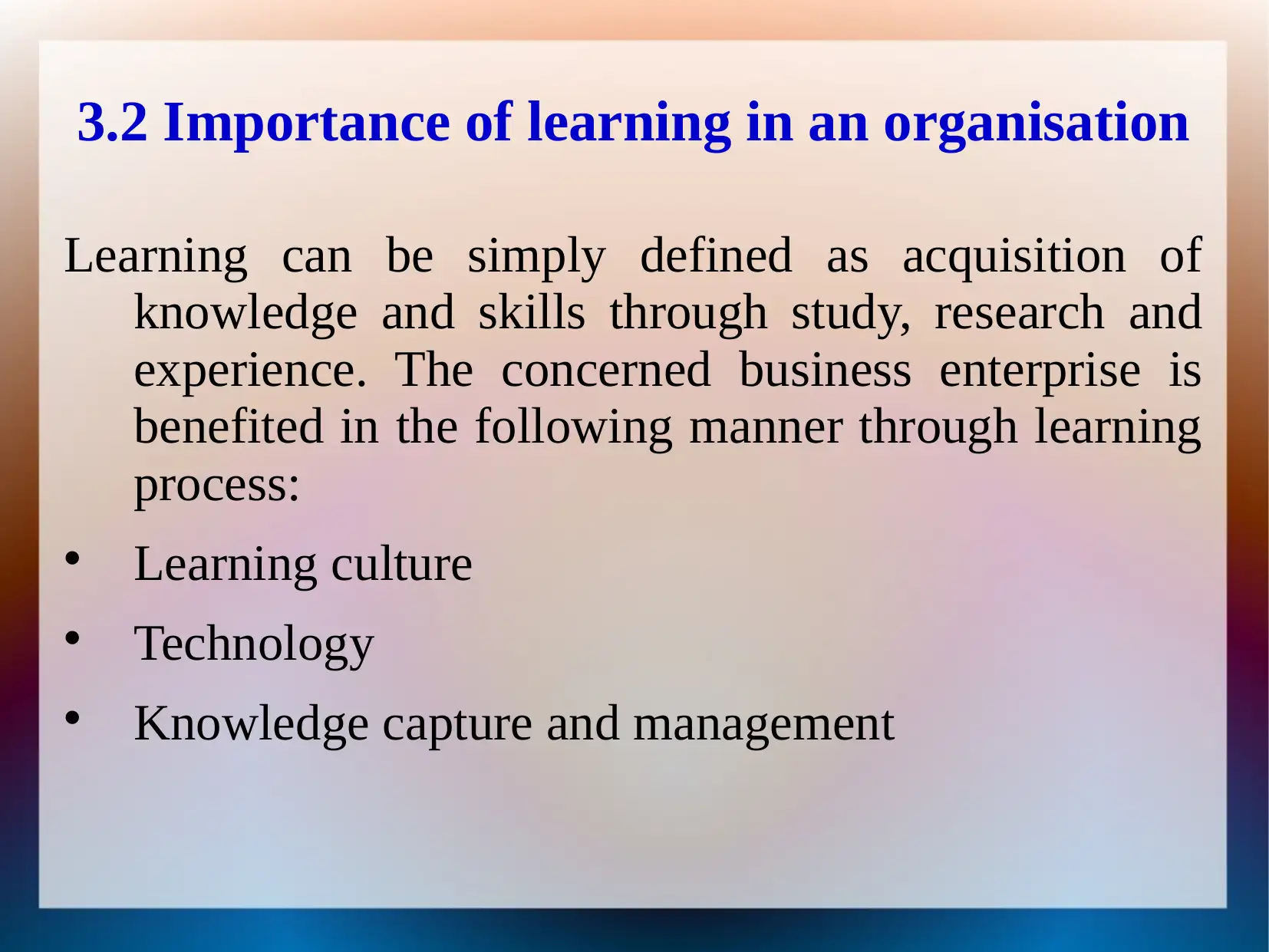
3.2 Importance of learning in an organisation
Learning can be simply defined as acquisition of
knowledge and skills through study, research and
experience. The concerned business enterprise is
benefited in the following manner through learning
process:
Learning culture
Technology
Knowledge capture and management
Learning can be simply defined as acquisition of
knowledge and skills through study, research and
experience. The concerned business enterprise is
benefited in the following manner through learning
process:
Learning culture
Technology
Knowledge capture and management
Paraphrase This Document
Need a fresh take? Get an instant paraphrase of this document with our AI Paraphraser
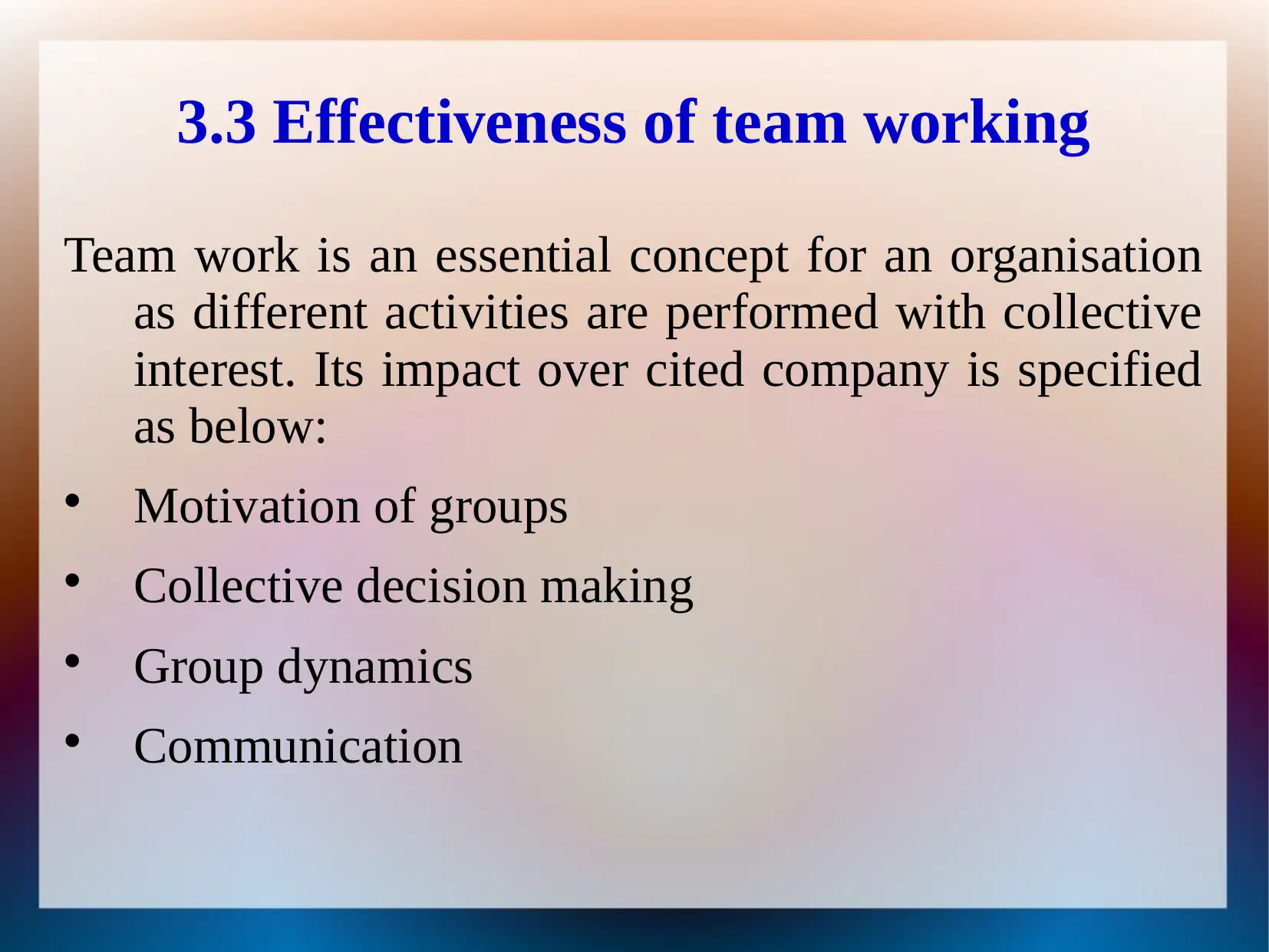
3.3 Effectiveness of team working
Team work is an essential concept for an organisation
as different activities are performed with collective
interest. Its impact over cited company is specified
as below:
Motivation of groups
Collective decision making
Group dynamics
Communication
Team work is an essential concept for an organisation
as different activities are performed with collective
interest. Its impact over cited company is specified
as below:
Motivation of groups
Collective decision making
Group dynamics
Communication
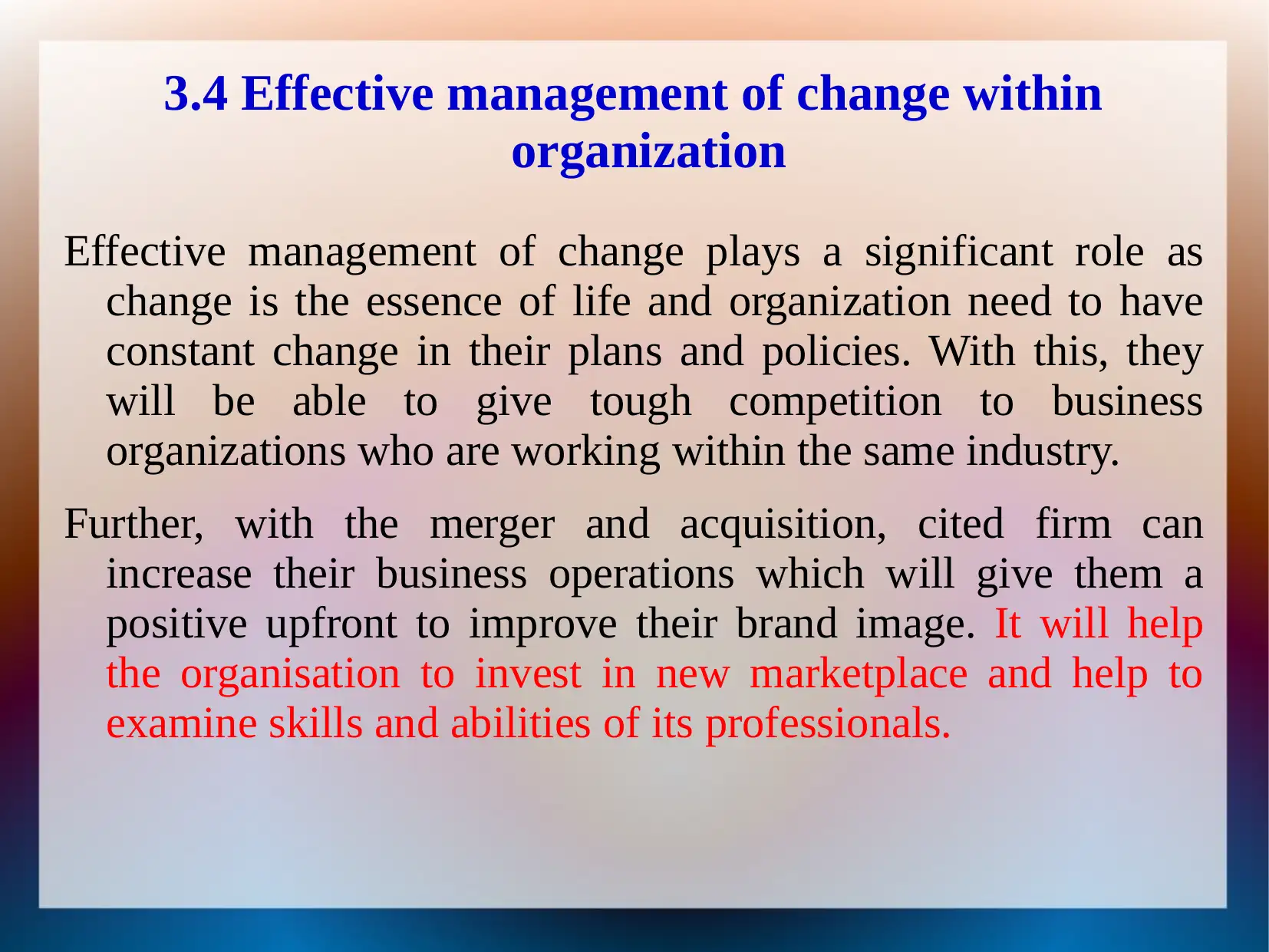
3.4 Effective management of change within
organization
Effective management of change plays a significant role as
change is the essence of life and organization need to have
constant change in their plans and policies. With this, they
will be able to give tough competition to business
organizations who are working within the same industry.
Further, with the merger and acquisition, cited firm can
increase their business operations which will give them a
positive upfront to improve their brand image. It will help
the organisation to invest in new marketplace and help to
examine skills and abilities of its professionals.
organization
Effective management of change plays a significant role as
change is the essence of life and organization need to have
constant change in their plans and policies. With this, they
will be able to give tough competition to business
organizations who are working within the same industry.
Further, with the merger and acquisition, cited firm can
increase their business operations which will give them a
positive upfront to improve their brand image. It will help
the organisation to invest in new marketplace and help to
examine skills and abilities of its professionals.
⊘ This is a preview!⊘
Do you want full access?
Subscribe today to unlock all pages.

Trusted by 1+ million students worldwide
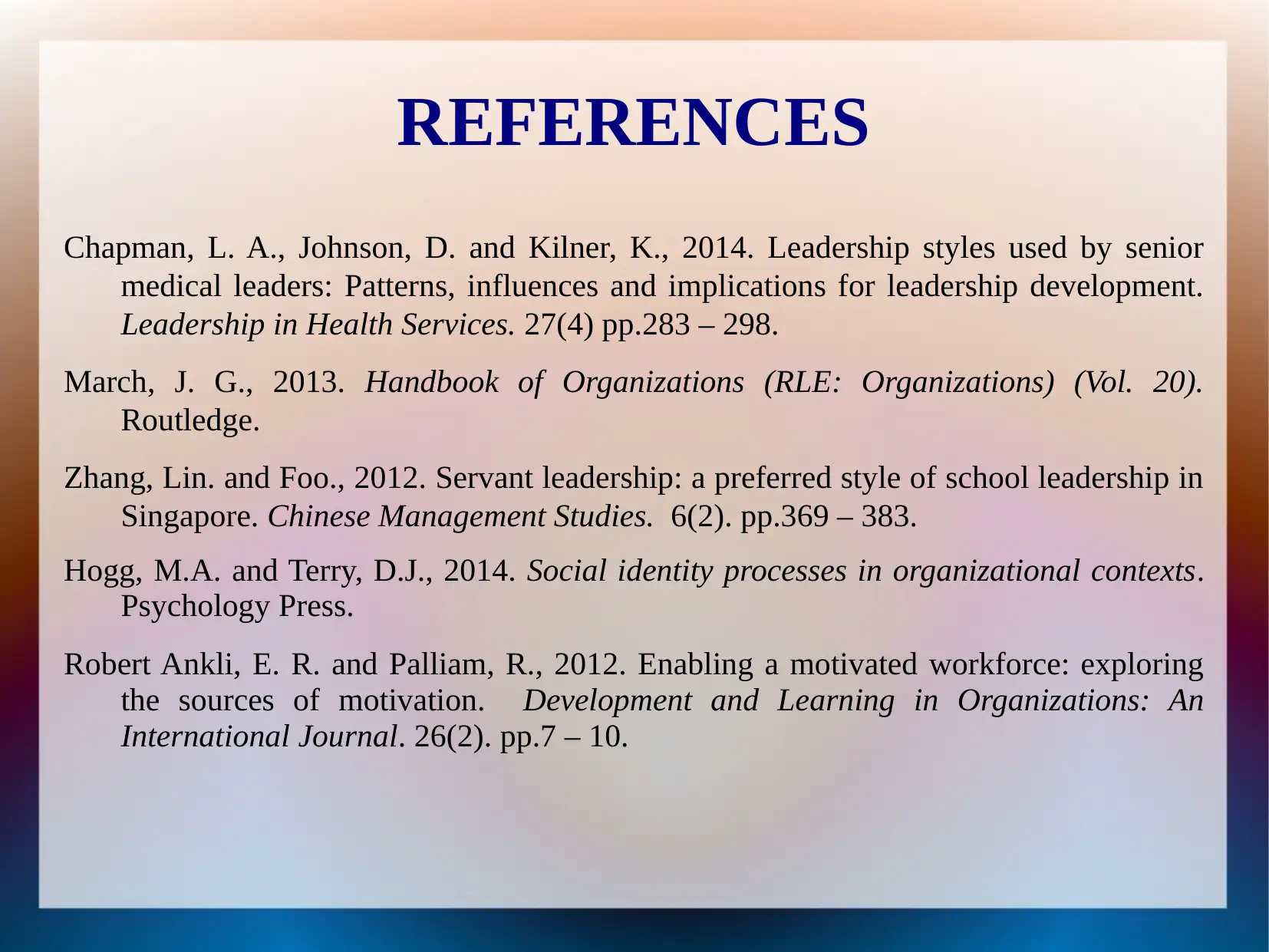
REFERENCES
Chapman, L. A., Johnson, D. and Kilner, K., 2014. Leadership styles used by senior
medical leaders: Patterns, influences and implications for leadership development.
Leadership in Health Services. 27(4) pp.283 – 298.
March, J. G., 2013. Handbook of Organizations (RLE: Organizations) (Vol. 20).
Routledge.
Zhang, Lin. and Foo., 2012. Servant leadership: a preferred style of school leadership in
Singapore. Chinese Management Studies. 6(2). pp.369 – 383.
Hogg, M.A. and Terry, D.J., 2014. Social identity processes in organizational contexts.
Psychology Press.
Robert Ankli, E. R. and Palliam, R., 2012. Enabling a motivated workforce: exploring
the sources of motivation. Development and Learning in Organizations: An
International Journal. 26(2). pp.7 – 10.
Chapman, L. A., Johnson, D. and Kilner, K., 2014. Leadership styles used by senior
medical leaders: Patterns, influences and implications for leadership development.
Leadership in Health Services. 27(4) pp.283 – 298.
March, J. G., 2013. Handbook of Organizations (RLE: Organizations) (Vol. 20).
Routledge.
Zhang, Lin. and Foo., 2012. Servant leadership: a preferred style of school leadership in
Singapore. Chinese Management Studies. 6(2). pp.369 – 383.
Hogg, M.A. and Terry, D.J., 2014. Social identity processes in organizational contexts.
Psychology Press.
Robert Ankli, E. R. and Palliam, R., 2012. Enabling a motivated workforce: exploring
the sources of motivation. Development and Learning in Organizations: An
International Journal. 26(2). pp.7 – 10.
Paraphrase This Document
Need a fresh take? Get an instant paraphrase of this document with our AI Paraphraser

THANK YOU!!
1 out of 11
Related Documents
Your All-in-One AI-Powered Toolkit for Academic Success.
+13062052269
info@desklib.com
Available 24*7 on WhatsApp / Email
![[object Object]](/_next/static/media/star-bottom.7253800d.svg)
Unlock your academic potential
Copyright © 2020–2025 A2Z Services. All Rights Reserved. Developed and managed by ZUCOL.





